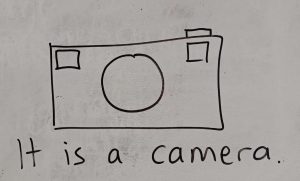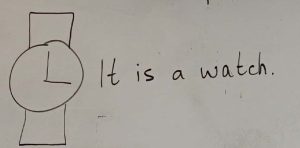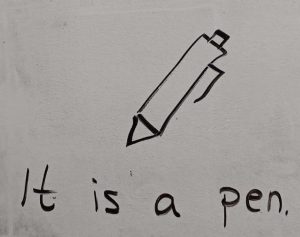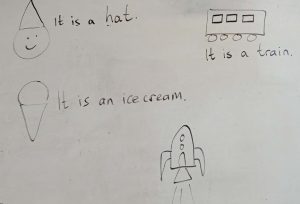I recently had the satisfaction of hearing my students make noises such as:
‘Aaaaah’ (I understand)
‘Ooooh’ (How cool!)
‘Haha’ (How funny! This class is great!)
Hearing students make those sounds is what I live for as a teacher. It’s those moments that make you think there can’t possibly be a better job in the world.
So what was I doing? A simple listening activity using basic shapes with my beginner class. We were revising common objects (e.g. a watch, a camera) with the form ‘It is a/an’.
You may have noticed that my drawings are as simple as I can make them. They are often made of basic shapes such as squares, circles, triangles, rectangles, lines and squiggles. If you can form these shapes, and write the alphabet, then you can draw. It is especially easy to draw common objects with these shapes.
First, I drew basic shapes on the board. Then we revised prepositions of place and phrases like ‘bottom left’ and ‘top right’ (which I find particularly useful for navigating the screen in online lessons).

Then I gave them all a sheet of A4 printer paper and dictated the following:
Object 1: Draw a rectangle. In the centre of the rectangle, draw a big circle. In the top right corner, draw a small square. On top of the rectangle, in the top right, draw a small rectangle.

Object 2: Draw a circle. On top of the circle, draw a square. Under the circle, draw a square. In the middle of the circle, draw a line. Start in the middle and go right. Draw one more line. Start in the middle and go up.

Object 3: Draw a long rectangle. On the top right, draw a small rectangle. Draw lines in the small rectangle from the top to the bottom.

Object 4: Draw a long rectangle. On the left of the triangle, draw a triangle. On the right, draw a small square.

By now, students were getting it. Drawings are just a collection of shapes. I did this with two different classes and in the second class, students got quite excited and started creating their own. Here’s what they described, with much hilarity:

I did this with my beginner classes. One group has slightly stronger listening skills and they drew as I spoke, the other needed a little more support. For them, I dictated, then I demonstrated on the whiteboard if they needed it.
Each group made the same noises! I’d be really keen to hear if your students have the same reactions! I’d also be interested to hear how higher levels get on with this activity. I think it would still challenge them. You could read it faster, or make the objects more intricate.
If you’d like to brush up on your drawing skills and learn lots of ways to use drawing and graphic facilitation techniques for ELT, why not join one of my online courses? You can find information by clicking the laptop icon above.


